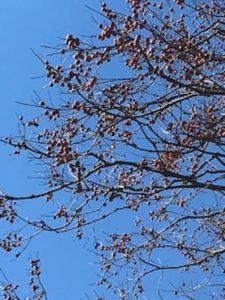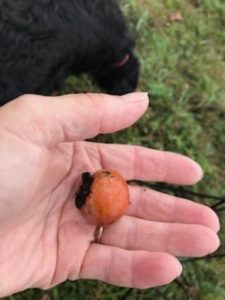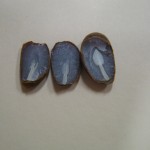
So you’re a country kid taking a walk in the autumn months and come across a persimmon tree. Older and wiser people are walking along with you and tell you that you have to try tasting one of those persimmons. You note their smile, but you’re a kid and you do want to try everything at least once, right? So you find one on the ground or maybe knock one off the tree. Since you lack the proper experience with persimmons, you aren’t particularly picky. You take a little nibble because even though you want to try things you don’t want to jump in the deep end before you know a little more about the water. But the nibble is enough. Pucker time. Your mouth turns inside out while those older and wiser people laugh. You don’t get angry because you know that once they were the kid with someone telling them to try the persimmon pucker.
 The little fruits on the trees here in Kentucky are pale orange and not very big with several seeds. The fruit is edible and ripens in September or October. While delicious when ripe, it is as one site states, highly unpleasant before ripening. That’s because the fruit before it’s ripe contains a large amount of tannin and are astringent. Trust me, it really is. Or don’t trust me. Everybody should try a green persimmon once in their life. There is nothing like experience to help one remember that some fruit is better ripe.
The little fruits on the trees here in Kentucky are pale orange and not very big with several seeds. The fruit is edible and ripens in September or October. While delicious when ripe, it is as one site states, highly unpleasant before ripening. That’s because the fruit before it’s ripe contains a large amount of tannin and are astringent. Trust me, it really is. Or don’t trust me. Everybody should try a green persimmon once in their life. There is nothing like experience to help one remember that some fruit is better ripe.
We have a tree that is absolutely loaded with the fruit this year. More than I’ve ever seen on a persimmon tree. The animals love them, including Frankie. You can see him nosing around for one in the background on the picture. But most of the time the ground under the tree is picked clean. Probably by deer and possoms and raccoons and maybe a coyote or two. The cows may help too. I needed to put the trail camera out there to see what came in the night to eat the fruit.
I’ve even eaten a few since I am one of those older and wiser ones now who know to wait until the fruit is a nice orange, a little mushy and definitely ripe. It’s not bad and I think about how happy I would have been if I lived back in pioneer days to find a loaded down persimmon tree. I’d have been fighting the critters over them then. Oh, and I do admit to trying to get the grandkids to try one. It’s part of being a country kid.
Common persimmon was introduced into the landscape in 1629. Native Americans made persimmon bread and dried the fruit. Some make cakes, puddings and beverages from the fruit. Persimmons have also been used to make tea for use in gargling for sore throats and to treat warts, cancers, heartburn, diarrhea and stomach aches. Not sure if that is when ripe or while it still has that astringent quality. You know, medicine rarely tastes good. 🙂 Cooking oil, with a flavor like that of peanut oil, can be extracted from the seeds. Confederate soldiers boiled persimmon seeds as a coffee substitute during the Civil War. As a plus, persimmon wood is very hard and nearly black. It is used to make golf club heads, billiard cues and parquet flooring.

https://caldwell.ces.ncsu.edu/ 2012/12/persimmon-tree/
The berry type fruit does contain several seeds. Facebook friends told me you can predict the winter with the seeds and I kept looking at the seeds and wondering what they were talking about. I couldn’t see anything but a smooth seed, but then I saw this site that says you have to break open the seeds. Ahh! So later today if I can keep Frankie from grabbing the persimmons on the ground first, I’ll do another check of those seeds and report on the winter to come. Here’s what you look for inside the seed.
- If the kernel is spoon-shaped, expect plenty of snow to shovel.
- If it is fork-shaped, plan on a mild winter with powdery, light snow.
- If the kernel is knife-shaped, expect frigid winds that will “cut” like a blade.
Have you ever eaten a persimmon? A ripe one or one that gave you that persimmon pucker?
Thanks as always for reading.
P.S. Melissa Henderson was the winner of her choice of my previous Shaker books. I’ll be in touch, Melissa. Thanks to all of you who commented on my the cover of my upcoming Shaker book, The Refuge, and those of you who comment here any time. I appreciate you reading my words and joining in the conversation.


Comments 16
Ann, as a child I don’t remember eating one. I do remember my grandmother making bread and other things with them. As a young woman, I was out deer scouting with my husband and brother. I found a tree and it had lots on it. When questioned my husband assured me it was fruit and could be eaten, then my brother reminded me of Grandma Brown baking with them. I immediately took a bite and had numerous bad thoughts about both men who were laughing so hard. They explained if I had of waited they would have informed me you only ate them after a frost. Of course I didn’t believe a word they said, needless to say lesson learned. lol Everyone here in western Kentucky have reported finding spoons, but in Evansville, Indiana I’ve heard reports of a knife being found. I have tried this two years in a row with accurate predictions. Good luck.
Author
Thanks for your persimmon story, Katrina. Getting a kid to eat one of those not ripe yet persimmons is something all guys seem to want to do. Probably because they all had the same trick played on them when they were younger. I’d never heard of the weather predicting abilities of the persimmon seed until last year and then didn’t realize until this year you had to cut the seed open. Now it’s sort of neat, but I’d just as soon have a mild winter without much snow. 🙂
Ohhh, Ann…I wish I’d gotten a picture with you… and one with Angela, too! I’m glad she showed up. What a fun day it was! I’m already looking forward to next year’s fair. 🙂
Author
It’s always a good Book Fair, Lavon. And although it’s not as close as Frankfort was for me, it’s not bad to get to since the Horse Park is right off the interstate. I’m glad I got to see you and that you had a good time.
I don’t care for persimmons even when they’re ripe.
Author
I’m not a big fan either, Karen. I think I was ruined by that first taste when the persimmon was too green. But I did taste some of these and they weren’t bad. Frankie loved them.
We were always told not to eat persimmons until after the first heavy frost. Then they weren’t puckery. My sister Carolyn loved them. Me not so much.lol
Author
Actually, Judy, I’ve always been told that too about the frost, but these did get ripe before the frost. You could tell the ripe ones by the color and also if they were a little mushy. Frankie didn’t seem to be picky. He ate them ripe or not ripe, seeds, stem and all. He also loved sniffing around where the other critters had been there eating before we showed up under the tree.
I’ve never eaten one or seen a tree. I’ve lived in the country all my life but I guess not near a persimmon tree, ha!
Author
Could be you just haven’t noticed, Connie. Very few persimmon trees I’ve seen are as loaded as this one. Most I’ve seen in the woods blend right in and might not even be noticed although the animals surely track down those trees to enjoy the fruit.
It is funny that you wrote about persimmons today! Just Friday, I was thinking about persimmons and where or if I could find some. I was remembering the persimmon tree we had on the back of the farm Mom would send us to to pick persimmons so that she could make a persimmon pie (or pudding, I forget now). We would eat a couple of persimmons as we picked them. They were so good and I haven’t had any since back in those days!
Author
We never made anything out of persimmons, Linda Dianne. We just sampled them if we thought they were ripe. We were very tentative about it to make sure they were edible and not going to pucker our mouth. A little tongue taste before you were brave enough to eat the whole thing. But there are many recipes for persimmon this or that online. Of course, the trees out in California have persimmons the size of apples. That would make them easier to use in cooking.
We have 2 persimmon trees, but they’re the Japanese variety. We have both the Fuyu (can be eaten like an apple) and the Hachiya (the puckery type). I wasn’t a fan until I discovered persimmon cookies! Neither of the Japanese kinds have big seeds! I just read up on Wikipedia about persimmons and discovered there’s LOTS of different varieties all over the world!
Author
I have a friend who grew up here in Kentucky but lived for many years in California, Margaret. She commented on my Facebook page yesterday that she once brought home a persimmon from a California tree and nobody here could guess what it was. There are many different kinds. Here the fruit is pretty small with plenty of seeds. Sounds like persimmon cookies would be worth a try.
My grandfather introduced me to the persimmon pucker when I was young….ooooweee!
I didn’t know about predicting the weather with the seeds though. I might have to find a persimmon tree now.
Have a wonderful Thanksgiving week, Ann. Many blessings to you and your family!
Author
It’s a rite of passage if you’re a country girl, Lavon. Made me not want to taste another one for about fifty years. But I did try some this year. They weren’t bad.
So fun to see you at the Book Fair. I wish I’d thought to get a picture with you.